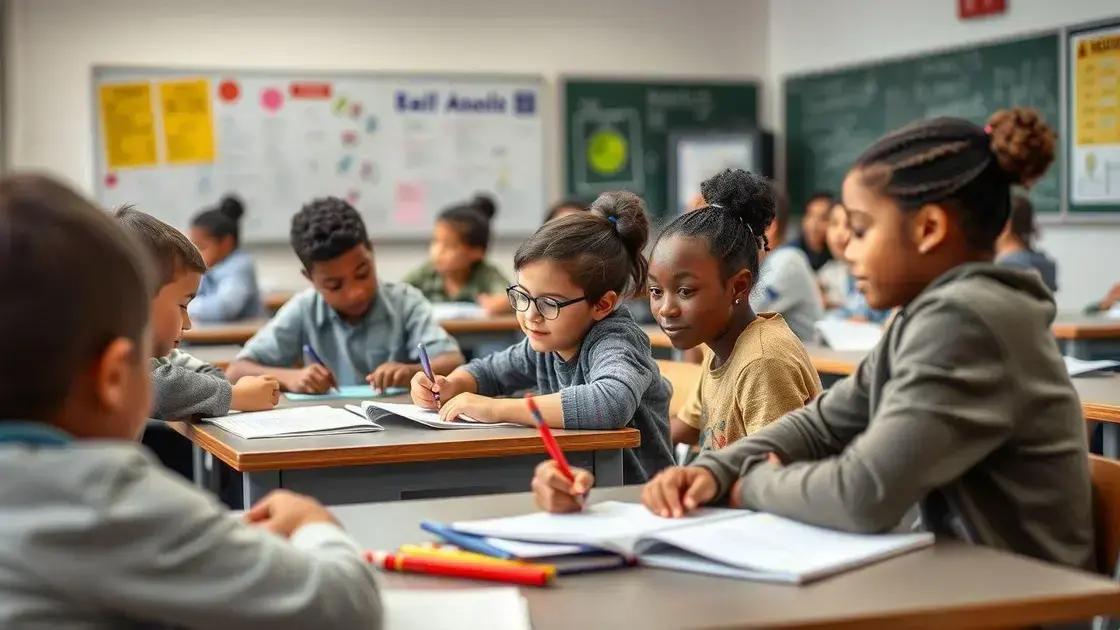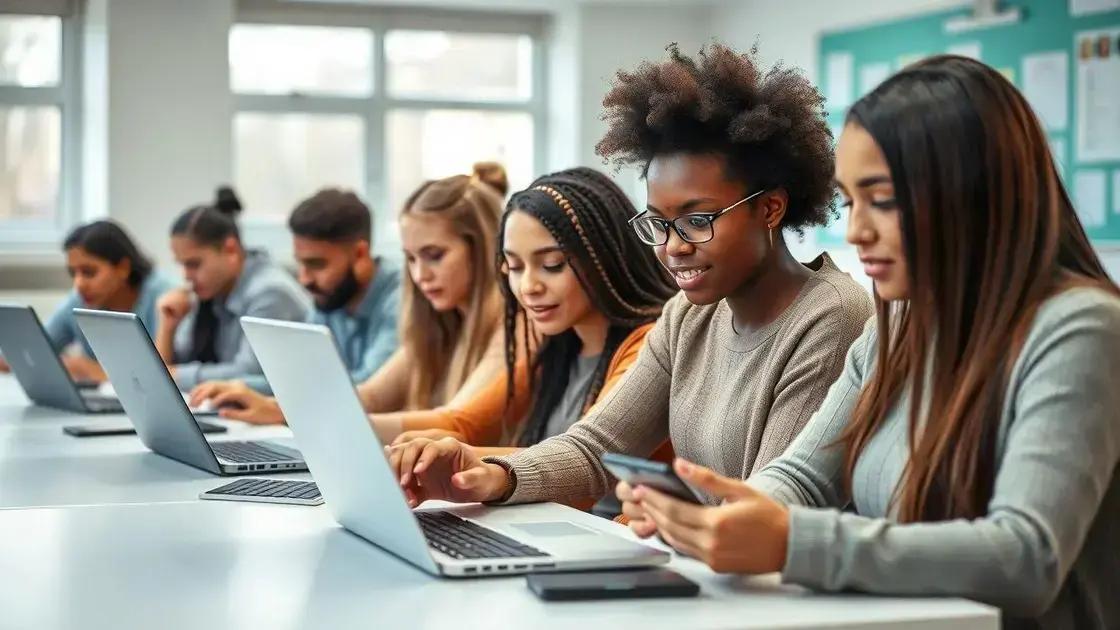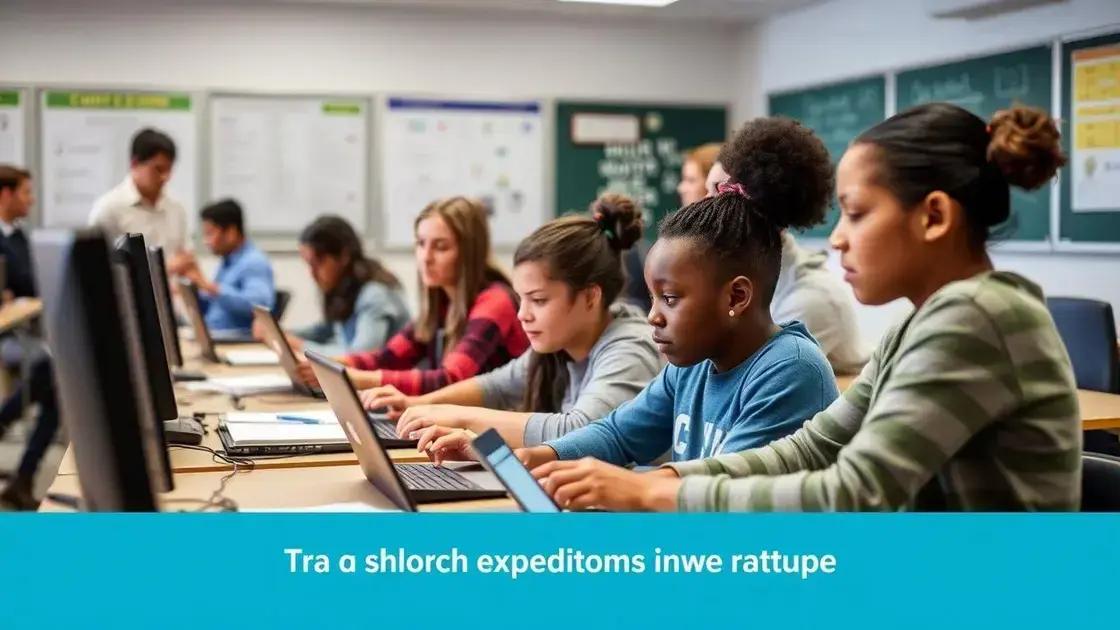Digital classrooms revolutionize modern education

Anúncios
Digital classrooms leverage technology to enhance learning through personalized experiences, interactive content, and flexible access, but also face challenges like engagement and access issues while future trends include AI integration and blended learning models.
Digital classrooms are changing the way we learn and teach, bringing education to life with technology. Have you ever wondered how they can enhance your learning experience? Let’s dive into this fascinating world.
Anúncios
Understanding digital classrooms
Understanding digital classrooms is essential for navigating today’s educational landscape. These innovative environments utilize technology to enhance learning and engagement.
In a digital classroom, students access resources and communicate through digital platforms. The integration of technology means that learning can happen anywhere and anytime, making education more flexible.
Anúncios
Key Features of Digital Classrooms
There are several critical elements that define a digital classroom.
- Interactive Learning: Students actively participate in lessons through discussions and online activities.
- Resource Accessibility: Learning materials are easily accessible via digital devices, allowing for personalized learning experiences.
- Collaboration Tools: Platforms like Google Classroom or Microsoft Teams make it easier for students to work together, regardless of location.
Technology not only enhances accessibility but also helps in tailoring educational experiences. For instance, teachers can use data analytics to understand each student’s strengths and weaknesses and adjust their teaching methods accordingly.
Moreover, digital classrooms offer diverse learning styles. Visual learners benefit from videos and interactive modules, while auditory learners can access podcasts and discussions.
Engagement and Interaction
Engaging students is a hallmark of a successful digital classroom. Using multimedia tools keeps lessons interesting. Teachers can incorporate games and quizzes to make learning fun.
Additionally, feedback is immediate in these settings. Students can receive real-time responses from their peers and teachers, fostering a dynamic learning environment.
The use of virtual environments also prepares students for future workplaces. Familiarity with digital interfaces and online collaboration is crucial in today’s job market.
Adopting digital classrooms will continue to evolve. As technology progresses, so will educational strategies aiming to engage and accommodate all learners.
Key benefits of digital classrooms for students
One of the main reasons digital classrooms are gaining popularity is the numerous benefits they offer to students. With technology integrated into learning, education becomes more accessible and engaging.
In a digital classroom, students can learn at their own pace. This flexibility allows them to revisit challenging concepts and take the time they need to fully understand the material.
Direct Benefits of Digital Classrooms
There are several key advantages that stand out:
- Enhanced Engagement: Digital tools make lessons interactive and fun, helping to keep students focused.
- Individualized Learning: Tailored learning experiences cater to different learning styles and preferences.
- Accessibility: Students can access materials anytime and anywhere, making education more inclusive.
These factors contribute to a positive learning environment, where students feel empowered to take charge of their education. The use of multimedia resources such as videos, simulations, and interactive quizzes facilitates better understanding and retention of knowledge.
Additionally, digital classrooms facilitate collaboration among students. By working on group projects using online platforms, students learn valuable social skills. They gain experience in teamwork and communication that is essential for their future careers.
Resource Availability
Another significant benefit is the availability of various resources. Students can easily access textbooks, articles, and other digital materials that enhance their learning experience.
Digital classrooms also encourage critical thinking skills. Students learn to analyze information from multiple sources and form their own opinions, which is crucial for success in higher education and the workforce.
With the increasing integration of technology in education, the benefits of digital classrooms are clear. They not only improve learning outcomes but also prepare students for a technology-driven future.
Tools and technologies for effective digital classrooms

Tools and technologies play a vital role in creating effective digital classrooms. These resources enhance the learning experience, making education more engaging and accessible for all students.
One key aspect of a successful digital classroom is the use of interactive platforms. These tools help in facilitating discussions and collaborative learning among students.
Essential Tools for Digital Classrooms
Here are some of the essential tools used in digital classrooms:
- Learning Management Systems (LMS): Platforms like Moodle or Canvas help in organizing course materials, assignments, and communication.
- Video Conferencing Tools: Applications such as Zoom and Google Meet allow for real-time interaction with teachers and peers.
- Collaborative Tools: Tools like Google Docs and Microsoft Teams enable students to work together on projects and presentations from different locations.
Additionally, using multimedia resources enriches the learning experience. Videos, podcasts, and interactive simulations make complex topics easier to understand. This variety caters to different learning styles, helping students engage with the material.
Moreover, incorporating classroom management technology assists teachers in monitoring student progress and behavior effectively. Software solutions can track assignments and participation, making it easier to provide feedback.
Assessment Technologies
Assessment tools are also crucial in digital classrooms. They allow teachers to evaluate student performance more efficiently.
Platforms like Kahoot and Quizizz make quizzes fun and interactive, encouraging student participation. These assessments provide immediate feedback, helping students identify areas for improvement.
With all these tools, digital classrooms are becoming more effective at meeting the diverse needs of learners. As technology continues to advance, educators can create even more engaging and personalized learning environments.
Challenges in implementing digital classrooms
Implementing digital classrooms can come with several challenges that educators and institutions must navigate. Understanding these obstacles is essential for creating a successful learning environment.
One major challenge is the lack of access to technology for some students. Not every student has a laptop or stable internet connection at home, which can hinder their ability to participate fully in a digital classroom.
Insufficient Training for Educators
Another barrier is the need for adequate training for teachers. Many educators may not feel comfortable using new technologies. This can affect their ability to engage students effectively.
Professional development programs are crucial for helping teachers learn how to use digital tools effectively. Schools must prioritize training to ensure educators are confident and capable.
Maintaining Student Engagement
Keeping students motivated in a digital classroom can also pose a challenge. Without face-to-face interaction, some students may struggle with focus and engagement.
This situation can be addressed by incorporating interactive elements, such as quizzes, discussions, and group projects. Making learning fun and collaborative helps to maintain student interest.
Moreover, regular communication with students is vital. Educators can use video calls or messaging apps to check in and provide support. This connection helps students feel more engaged.
Technical Issues
Technical issues can disrupt learning in digital classrooms. Problems like software glitches, device malfunctions, or connectivity issues can frustrate both teachers and students.
To minimize these disruptions, schools should ensure that they have reliable technical support available. Regular maintenance and updates of software and hardware can also prevent many common issues.
By addressing these challenges, schools can create a more effective and inclusive digital classroom. Understanding obstacles leads to better strategies for overcoming them, ultimately enhancing the learning experience for all students.
Future trends in digital classroom education
Future trends in digital classroom education are shaping how students learn. As technology advances, classrooms are becoming more interactive and personalized.
One key future trend is the rise of artificial intelligence (AI) in education. AI can provide personalized learning experiences by adapting to individual student needs. This technology helps identify strengths and weaknesses, allowing for tailored lesson plans.
Blended Learning Models
Another trend is the implementation of blended learning models. These models combine online and face-to-face instruction, providing flexibility for both teachers and students.
In this approach, students can learn at their own pace online while still benefiting from in-person guidance. This flexibility promotes a more engaging and effective learning environment.
Increased Use of Virtual Reality
Virtual reality (VR) is also gaining traction in digital classrooms. VR technology allows students to immerse themselves in their subjects, providing experiences that are impossible in traditional classrooms.
For example, students can explore ancient civilizations or conduct virtual science experiments in a safe space. This immersive learning experience enhances understanding and retention of information.
Focus on Social-Emotional Learning
Future trends also include a greater emphasis on social-emotional learning (SEL). Educators are recognizing the importance of developing students’ emotional intelligence alongside academic skills.
Using digital platforms, teachers can incorporate SEL activities that promote empathy, resilience, and teamwork. This holistic approach helps students thrive academically and personally.
As these trends continue to evolve, digital classrooms are set to become increasingly dynamic. Embracing new technologies and methodologies will prepare students for a rapidly changing world.
FAQ – Frequently Asked Questions about Digital Classrooms
What are digital classrooms?
Digital classrooms are educational environments that use technology to facilitate learning. They often include online resources, digital tools, and interactive platforms.
How do digital classrooms enhance learning?
Digital classrooms enhance learning by providing personalized experiences, engaging multimedia content, and flexible access to resources.
What challenges do educators face with digital classrooms?
Educators often face challenges such as ensuring access to technology, maintaining student engagement, and managing technical issues.
What future trends are emerging in digital classrooms?
Future trends include the use of AI for personalized learning, blended learning models, and increased focus on social-emotional learning.






